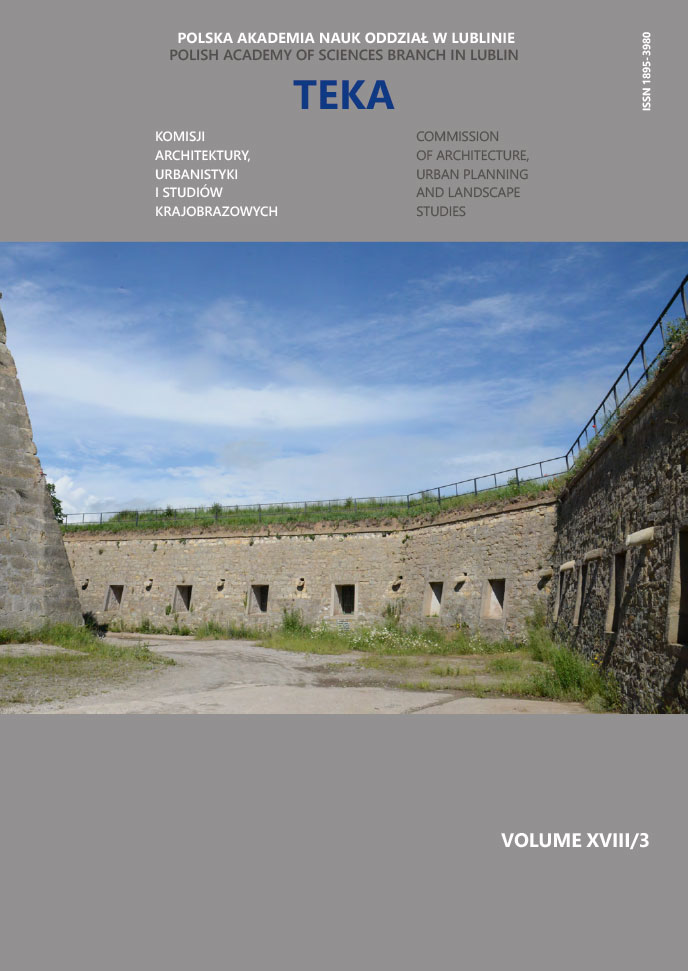Badania historycznych zapraw z Baszty Gotyckiej w Lublinie
##plugins.themes.bootstrap3.article.sidebar##
Open full text
Numer Tom 18 Nr 3 (2022)
-
Stan zachowania wernakularnych obiektów drewnianych Muzeum Wsi Lubelskiej
Weronika Kendzierawska, Maciej Trochonowicz7-17
-
Badania historycznych zapraw z Baszty Gotyckiej w Lublinie
Beata Klimek18-29
-
Wpływ wilgotności powietrza i temperatury na współczynnik przewodzenia ciepła tynków perlitowych
Bartosz Szostak, Maciej Trochonowicz, Paulina Hendzel30-40
-
Niezwykły modernizm w odbudowie śródmieścia Hawru na przykładzie kościoła pw. św. Józefa projektu Aguste’a Perreta
Paweł Piotr Szumigała, Karolina Olenia Szumigała41-50
-
Określenie tożsamości miejsca poprzez analizę przestrzenno-krajobrazową. Studium przypadku dawnej miejscowości Wieniawa w Lublinie
Wojciech Jabłoński51-60
Archiwum
-
Tom 20 Nr 3
2024-12-27 7
-
Tom 20 Nr 2
2024-12-27 7
-
Tom 20 Nr 1
2024-12-27 8
-
Tom 19 Nr 2
2023-12-29 11
-
Tom 19 Nr 1
2023-12-19 13
-
Tom 18 Nr 4
2022-12-30 5
-
Tom 18 Nr 3
2022-12-27 5
-
Tom 18 Nr 2
2022-12-27 5
-
Tom 18 Nr 1
2022-12-27 4
-
Tom 17 Nr 4
2021-12-30 11
-
Tom 17 Nr 3
2021-12-30 9
-
Tom 17 Nr 2
2021-12-30 8
-
Tom 17 Nr 1
2021-12-30 8
-
Tom 16 Nr 4
2020-12-30 11
-
Tom 16 Nr 3
2020-09-30 10
-
Tom 16 Nr 2
2020-06-30 11
-
Tom 16 Nr 1
2020-03-31 10
##plugins.themes.bootstrap3.article.main##
DOI
Authors
Abstrakt
Baszta Półokrągła, nazywana także Basztą Gotycką jest jedną z najstarszych budowli Lublina. Została zbudowana w XIV wieku z kamienia i cegły. Była częścią murów obronnych wzniesionych przez króla Kazimierza Wielkiego. W trakcie współcześnie wykonywanych prac restauratorskich, pobrano oryginalne materiały: zaprawy. W artykule przedstawiono charakterystykę mineralogiczną, chemiczną zapraw. Metodyka analityczna obejmowała: jakościową analizę mineralogiczną całej próbki metodą dyfrakcji rentgenowskiej (XRD); badania morfologiczne z pierwiastkową oceną i mikroanalizą spoiwa metodą skaningowej mikroskopii elektronowej i spektroskopię rentgenowską z dyspersją energii (SEM-EDS). Wykonano oznaczanie pozostałości części nierozpuszczalnych w kwasie solnym. Metodologia ta pozwoliła na określenie składu zapraw: badania podciągania nasiąkliwości w wodzie po 24 godzinach zanurzenia. Stwierdzono, że badane zaprawy mają podobną budowę mineralogiczną, lecz nieco różnią się udziałem poszczególnych składników, przede wszystkim frakcji kruszywa. Próbki składają się głównie z kwarcu i kalcytu i dodatkowo krzemianów. Ponadto wykazano, że spoiwo wapienne zapraw ma charakter mikrokrystaliczny. Do produkcji historycznych zapraw jako kruszywo wykorzystano głównie piasek kwarcowy i minerały z grupy skaleniowej i krzemianowej.
Słowa kluczowe:
Bibliografia
Teodorowicz-Czerepińska J., Michalska G., Baszta Półokrągła II (Jezuicka 5−7/Królewska 6), [w:] Mury miejskie Lublina, Lublin 2021, s. 162−168.
Widawski J., Miejskie mury obronne w Państwie Polskim do pocz. XV w., Warszawa 1973, s. 54.
Koziejowski W., Rozpoznanie historyczne Baszty Półokrągłej w Lublinie, [mps]1992, Archiwum WUOZ w Lublinie.
Kwiatkowski B., Janus K., Budowla baszty półkolistej (gotyckiej) w dawnej linii murów obronnych Lublina. Badania architektoniczne, [mps] 2018, Archiwum WUOZ w Lublinie.
Secco M. et al., Mineralogical clustering of the structural mortars from the Sarno Baths, Pompeii: a tool to interpret construction techniques and relative chronologies, „Journal of Cultural Heritage”, 2019, No 40, s. 265−273; https://doi.org/10.1016/j.culher.2019.04.016 [dostęp: 28.10.2022].
Vettori S. et al., Archaeometric and archaeological study of painted plaster from the Church of St. Philipin Hierapolis of Phrygia (Turkey), „Journal of Archaeological Science: Reports”, 2019, No 24, s. 869−878; https://doi.org/10.1016/j.jasrep.2019.03.008 [dostęp: 28.10.2022].
Miriello D. et al., New compositional data on ancient mortars and plasters from Pompeii (Campania – Southern Italy): archaeometric results and considerations about their time evolution, „Materials Characterization”, 2018, No 146, s. 189−203; https://doi.org/10.1016/j.matchar.2018.09.046 [dostęp: 28.10.2022].
Laycock E.A. et al., An investigation to establish the source of the Roman lime mortars used in Wallsend, UK, „Construction and Building Materials”, 2019, No 196, s. 611−625; https://doi.org/org/10.1016/j.conbuildmat.2018.11.108 [dostęp: 28.10.2022].
Borsoi G. et al., Analytical characterization of ancient mortars from the archaeological roman site of Pisões (Beja, Portugal), „Construction and Building Materials”, 2019, No 204, s. 597−608; https://doi.org/10.1016/j.conbuildmat.2019.01.233 [dostęp: 28.10.2022].
Van Balen K. et al., Introduction to requirements for and functions and properties of repair mortars, „Materials and Structures”, 2005, vol. 38, No 8, s. 781−785; https://doi.org/10.1007/BF02479291 [dostęp: 28.10.2022].
Bartz W. et al., Characterization of historical lime plasters by combined non-destructive and destructive tests: The case of the sgraffito in Boznow (SW Poland), „Construction and Building Materials”, 2012, No 30, s. 439−446; https://doi.org/10.1016/j.conbuildmat.2011.12.045 [dostęp: 28.10.2022].
Maravelaki-Kalaitzaki P. et al., Hydraulic lime mortars for the restoration of historic masonry in Crete. „Cement and Concrete Research”,2005, No 35, s. 1577−86; https://doi.org/10.1016/j.cemconres.2004.09.001 [dostęp: 28.10.2022].
Alvarez J.I. et al., Methodology and validation of a hot hydrochloric acid attack for the characterization of ancient mortars. „Cement and Concrete Research”,1999, No 29, s. 1061−1065; https://doi.org/10.1016/S0008−8846(99)00090−3 [dostęp: 28.10.2022].
Coroado J. et al., Characterization of renders, joint mortars, and adobes from traditional constructions in Aveiro (Portugal), „International Journal of Architectural Heritage”, 2010, No 4, s. 102−114; https://doi.org/10.1080/15583050903121877 [dostęp: 28.10.2022].
Moropoulou A. et al., Characterization of ancient, byzantine and later historic mortars by thermal and x-ray diffraction techniques,” Thermochimica Acta”, 1995, No 269, s. 779−795; https://doi.org/10.1016/0040−031(95)02571−5 [dostęp: 28.10.2022].
Arıoglu N. et al., A research about a method for restoration of traditional lime mortars and plasters: a staging system approach. „Building and Environment”, 2006, No 41, s. 1223−1230; https://doi.org/10.1016/j.buildenv.2005.05.015 [dostęp: 28.10.2022].
Owsiak Z., Microscopic methods for analysis of mortars from historical masonry structures,” Bulletin of the Polish Academy of Sciences: Technical Sciences”, 2021, No 69, no. 1, s. 1−8; https://doi.org/10.24425/bpasts.2021.136042 [dostęp: 28.10.2022].
Cultrone G, et al., Forced and natural carbonation of lime based mortars with and without additives: mineralogical and textural changes. „Cement and Concrete Research”, 2005, No 35, s. 2278−89. https://doi.org/10.1016/j.cemconres.2004.12.012 [dostęp: 28.10.2022].
Lawrence R, et al., Effects of carbonation on the pore structure of non-hydraulic lime mortars. „Cement and Concrete Research” 2007, No 37, s. 1059−69; https://doi.org/10.1016/j.cemconres.2007.04.011 [dostęp: 28.10.2022].
##plugins.themes.bootstrap3.article.details##
Abstract views: 169
Licencja

Utwór dostępny jest na licencji Creative Commons Uznanie autorstwa – Na tych samych warunkach 4.0 Miedzynarodowe.


